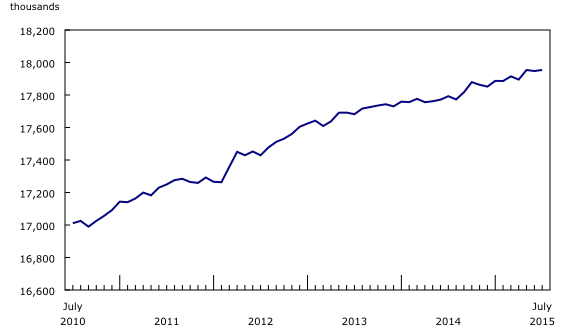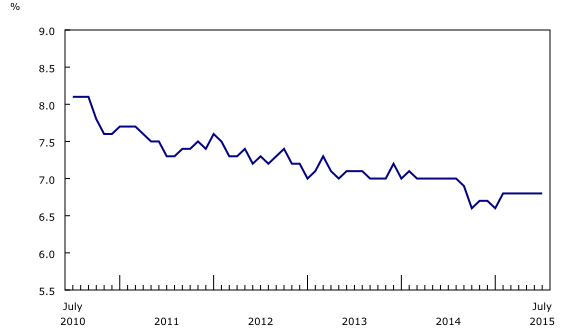Labour Force Survey, July 2015
Archived Content
Information identified as archived is provided for reference, research or recordkeeping purposes. It is not subject to the Government of Canada Web Standards and has not been altered or updated since it was archived. Please "contact us" to request a format other than those available.
Released: 2015-08-07
6.8%
July 2015
0.0 pts
(monthly change)
Employment was little changed in July (+6,600 or 0.0%) and the unemployment rate remained at 6.8% for the sixth consecutive month.
Compared with 12 months earlier, employment increased by 161,000 or 0.9%, the result of more full-time work. Over the same period, the total number of hours worked rose 1.2%.
In July, employment increased among men aged 25 to 54, while there was little change among the other demographic groups.
Provincially, employment rose in Quebec and Nova Scotia. At the same time, there were declines in Saskatchewan, Manitoba, and Prince Edward Island.
Employment was up in professional, scientific and technical services as well as public administration. There were fewer people working in finance, insurance, real estate and leasing.
The number of self-employed workers rose in July, while there was little change among public and private sector employees.
More men aged 25 to 54 employed
For men aged 25 to 54, employment rose by 19,000 in July. Compared with 12 months earlier, employment among this group was up by 66,000 (+1.1%) and their unemployment rate fell by 0.3 percentage points to 6.0%. At the same time, their participation rate increased 0.5 percentage points to 91.0%.
Among women aged 25 to 54, employment was virtually unchanged in July. However, on a year-over-year basis, employment for this group of women increased by 54,000 or 1.0%, and their unemployment rate fell by 0.5 percentage points to 5.2%. In July, their participation rate was 82.0%, little changed from 12 months earlier.
Employment among youths aged 15 to 24 was little changed, and their unemployment rate was also little changed at 13.2% in July. The participation rate for youths was 63.9%. On a year-over-year basis, there was virtually no change in either employment or the unemployment rate for this age group.
There was virtually no change in the employment level for men aged 55 and older in July. Compared with 12 months earlier, however, there were 69,000 (+3.6%) more men employed in this age group. Their unemployment rate was 6.4% and their participation rate was 43.6%, both little changed for the month and compared with July 2014.
For women aged 55 and older, employment was virtually unchanged both in July and compared with 12 months earlier. In the 12 months to July, their unemployment rate was little changed at 5.4%, and their participation rate declined 0.9 percentage points to 31.0%.
Provincial summary
Employment in Quebec increased by 22,000 in July, lowering the unemployment rate by 0.3 percentage points to 7.7%. Compared with 12 months earlier, employment in the province was up by 44,000 or 1.1%.
In Nova Scotia, employment rose by 3,100. The unemployment rate was little changed at 8.1% as a result of more people participating in the labour market. On a year-over-year basis, employment in the province was virtually unchanged.
Employment in Saskatchewan declined by 7,400 in July, and the unemployment rate increased 0.5 percentage points to 5.2%. With this decline, employment in the province was virtually unchanged compared with 12 months earlier.
In Manitoba, there were 3,800 fewer people working in July, and the unemployment rate increased 0.3 percentage points to 5.6%. Compared with July 2014, employment in the province was up by 6,000 or 1.0%.
Employment in Prince Edward Island fell by 800 in July. On a year-over-year basis, there were 1,900 fewer people working in the province and the unemployment rate increased 2.3 percentage points to 11.6%.
Employment in Ontario was unchanged in July. Compared with 12 months earlier, employment in the province was up by 67,000 (+1.0%) and the unemployment rate fell 1.1 percentage points to 6.4%, the lowest rate since September 2008.
Despite little change in the level of employment in Alberta, the unemployment rate increased by 0.3 percentage points to 6.0% in July as more people searched for work. Since January, the unemployment rate in the province has increased by 1.5 percentage points.
Industry perspective
In July, there were 19,000 more people employed in professional, scientific and technical services. Employment in this industry was up by 38,000 (+2.8%) compared with 12 months earlier.
Employment in public administration rose by 9,000. However, on a year-over-year basis, employment in this industry was down by 20,000 (-2.1%).
Employment fell by 10,000 in finance, insurance, real estate and leasing in July. Despite this decline, employment in the industry was up by 31,000 (+2.9%) compared with 12 months earlier.
The number of self-employed workers increased by 41,000 in July, contributing to a year-over-year increase of 57,000 or 2.1%.
The number of employees in both the public and private sector was little changed in July. On a year-over-year basis, employment rose by 75,000 or 0.7% in the private sector, while it was little changed in the public sector.
Summer employment for students
From May to August, the Labour Force Survey collects labour market data about youths aged 15 to 24 who attended school full time in March, and who intended to return full time in the fall. The published data are not seasonally adjusted; therefore, comparisons can only be made on a year-over-year basis.
Employment among students aged 20 to 24 edged down by 21,000 compared with 12 months earlier. Their unemployment rate was 8.2%, unchanged from July 2014, but down 1.5 percentage points from July 2013.
Among 17- to-19-year-old students, there was little change in employment compared with July 2014. Their unemployment rate was virtually unchanged at 16.9%.
Over the same period, there was little change in employment among students aged 15 and 16. Their unemployment rate rose 2.8 percentage points to 30.2% compared with July 2014, as more of them searched for work. This rate is similar to the rate observed two years earlier.
Note to readers
The Labour Force Survey (LFS) estimates for July are for the week of July 12 to 18.
The LFS estimates are based on a sample and are therefore subject to sampling variability. As a result, monthly estimates will show more variability than trends observed over longer time periods. For more information, see "Interpreting Monthly Changes in Employment from the Labour Force Survey." Estimates for smaller geographic areas or industries also have more variability. For an explanation of sampling variability of estimates and how to use standard errors to assess this variability, consult the "Data quality" section of the publication Labour Force Information (71-001-X).
This analysis focuses on differences between estimates that are statistically significant at the 68% confidence level.
The employment rate is the number of employed persons as a percentage of the population 15 years of age and over. The rate for a particular group (for example, youths aged 15 to 24) is the number employed in that group as a percentage of the population for that group.
The unemployment rate is the number unemployed as a percentage of the labour force (employed and unemployed).
The participation rate is the number of employed and unemployed as a percentage of the population.
For more detailed information, see the Guide to the Labour Force Survey (71-543-G).
Seasonal adjustment
Unless otherwise stated, this release presents seasonally adjusted estimates, which facilitates comparisons by removing the effects of seasonal variations. For more information on seasonal adjustment, see Seasonally adjusted data – Frequently asked questions.
Sample redesign
Every 10 years, the LFS undergoes a sample redesign to reflect changes in population and labour market characteristics, as well as new definitions of geographical boundaries. The redesigned sample was introduced starting in January 2015 and was fully implemented in June 2015.
Next release
The next release of the LFS will be on September 4.
Products
A more detailed summary, Labour Force Information (71-001-X), is now available for the week ending July 18. From the Browse by key resource module of our website under Publications, choose All subjects then Labour.
Summary tables are now available online. From the Browse by subject module of our website, choose Labour.
Contact information
For more information, contact us (toll-free 1-800-263-1136; 514-283-8300; infostats@statcan.gc.ca).
To enquire about the concepts, methods or data quality of this release, contact Andrew Fields (613-951-3551; andrew.fields@statcan.gc.ca) or Vincent Ferrao (613-951-4750; vincent.ferrao@statcan.gc.ca), Labour Statistics Division.
- Date modified:



